Hotpoint FZ 1021 P.1 IX NE User Manual

Operating Instructions
GB |
|
DE |
|
DK |
|
|
|
|
|
|
|
English,1 |
Deutsch, 14 |
Dansk, 27 |
|||
|
|
|
|
|
|
NO |
|
SE |
|
|
|
|
|
|
|
|
|
Norsk, 40 |
Svenska, 53 |
|
|
||
FZ 1021 P.1 NE
FZ 1021 P.1 IX NE
OVEN
Contents
GB
Installation, 2-3
Positioning Electrical connection Data plate
Description of the appliance, 4
Overall view
Control panel
Start-up and use, 5
Control panel lock
DEMO mode
Setting the clock and timer
Starting the oven
Cooking modes, 6-9
Manual cooking modes
Automatic cooking modes
Programming the cooking mode
Practical cooking advice
Cooking advice table
Precautions and tips, 10
General safety Disposal
Respecting and conserving the environment
Care and maintenance, 11-12
Switching the appliance off Cleaning the appliance Cleaning the oven door Replacing the light bulb
Automatic cleaning with the FAST CLEAN function
Assistance, 13
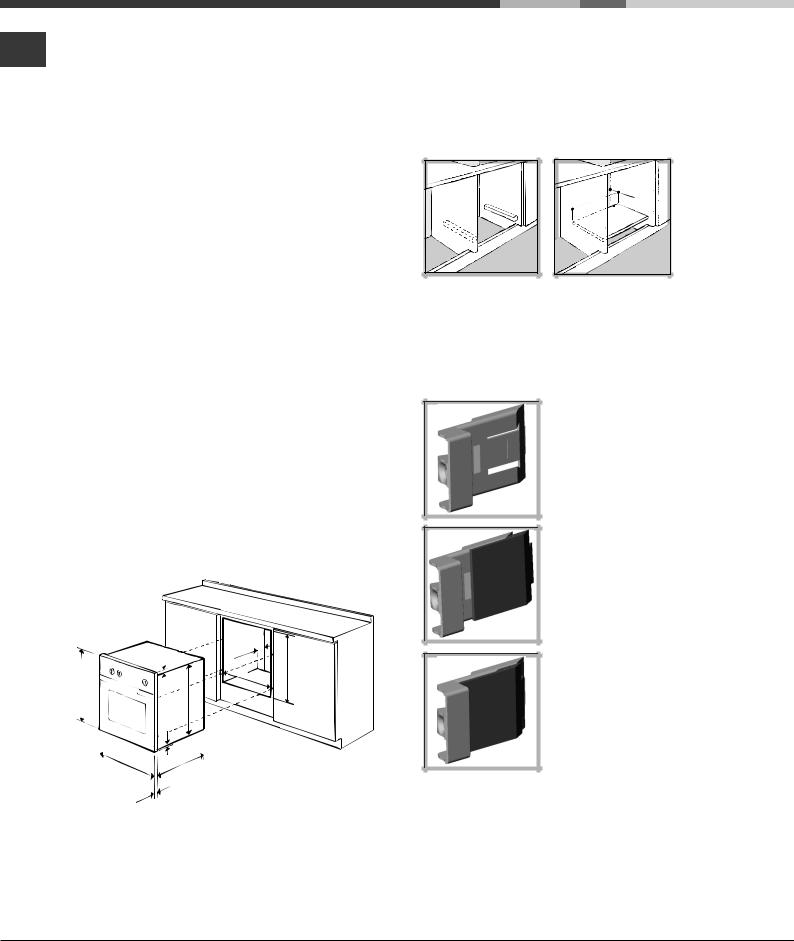
Installation
Before operating your new appliance please read GB this instruction booklet carefully. It contains important
information concerning the safe operation, installation and maintenance of the appliance.
Please keep these operating instructions for future reference. Pass them on to possible new owners of the appliance.
Positioning
Keep all packaging materials out of the reach of children. It may present a choking or suffocation hazard (see Precautions and tips).
The appliance must be installed by a qualified professional in accordance with the instructions provided. Incorrect installation may cause harm to people and animals or may damage property.
Built-in appliance
Use the appropriate cabinet to ensure that the appliance functions properly.
•The panels adjacent to the oven must be made of heat-resistant material.
•Cabinets with a veneer exterior must be assembled with glues which can withstand temperatures of up to 100°C.
•To install the oven under the counter (see diagram) and in a kitchen unit, the cabinet must have the following dimensions:
mm.23 |
. |
mm. |
|
mm |
|
|
45 |
|
mm.595 |
|
|
mm.567 |
558 |
mm. |
593 |
|
|
|
||||
|
|
|
|
|
|
|
|
595 |
|
5 mm. |
|
|
|
|
mm. |
. |
|
|
|
|
|
|
mm |
|
|
|
|
|
|
|
545 |
|
|
|
|
|
. |
|
|
|
|
|
|
mm |
|
|
|
|
|
24 |
|
|
|
|
|
The appliance must not come into contact with electrical parts once it has been installed.
The indications for consumption given on the data plate have been calculated for this type of installation.
Ventilation
To ensure adequate ventilation is provided, the back panel of the cabinet must be removed. It is advisable to install the oven so that it rests on two strips of wood, or on a completely flat surface with an opening of at least 45 x 560 mm (see diagrams).
. |
45 |
mm |
mm |
|
|
|
. |
|
560 |
|
|
Centring and fixing
Position the 4 tabs on the side of the oven so that they are lined up with the 4 holes on the outer frame. Adjust the tabs according to the thickness of the cabinet side panel, as shown below:
20 mm thick: take off the removable part of the tab (see diagram).
18 mm thick: use the first groove, which has already been set in the factory (see diagram).
16 mm thick: use the second groove (see diagram).
Secure the appliance to the cabinet by opening the oven door and putting 4 screws into the 4 holes on the outer frame.
All parts which ensure the safe operation of the appliance must not be removable without the aid of a tool.
2
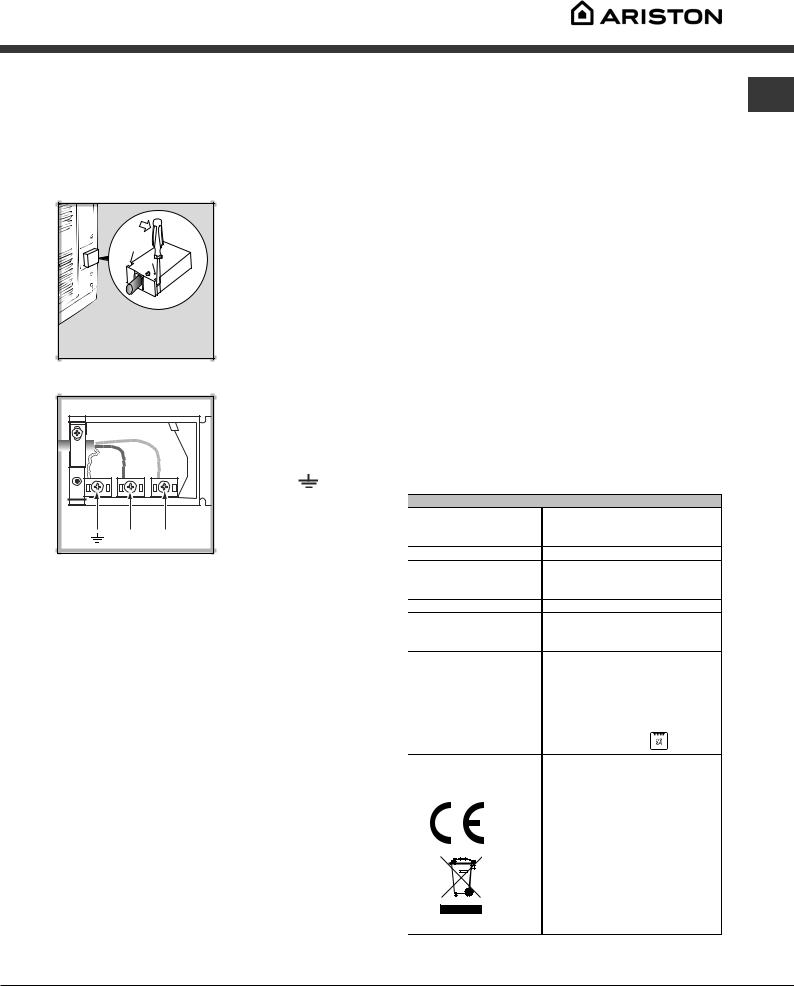
Electrical connection
Ovens equipped with a three-pole power supply cable are designed to operate with alternating current at the voltage and frequency indicated on the data plate located on the appliance (see below).
Fitting the power supply cable
1. Open the terminal board by inserting a screwdriver into the side tabs of the cover. Use the screwdriver as a lever by pushing it down to open the cover (see diagram).
|
|
2. Install the power |
|
|
|
supply cable by |
|
|
|
loosening the cable |
|
|
|
clamp screw and the |
|
|
|
three wire contact |
|
|
|
screws L-N- . |
|
|
|
Connect the wires to the |
|
|
|
corresponding |
|
N |
L |
terminals: the Blue wire |
|
to the terminal marked |
|||
|
|
||
|
|
(N), the Brown wire to |
the terminal marked (L) and the Yellow/Green wire to
the terminal marked |
|
|
|
|
|
|
(see diagram). |
|
|
|
|
|
|
||
|
|
|
|
|
|
|
|
3.Secure the cable by fastening the clamp screw.
4.Close the cover of the terminal board.
Connecting the supply cable to the mains
Install a standardised plug corresponding to the load indicated on the data plate (see table).
The appliance must be directly connected to the mains using an omnipolar circuit-breaker with a minimum contact opening of 3 mm installed between the appliance and the mains. The circuit-breaker must be suitable for the charge indicated and must comply with current electrical regulations (the earthing wire must not be interrupted by the circuit-breaker). The supply cable must be positioned so that it does not come into contact with temperatures higher than 50°C at any point.
The installer must ensure that the correct electrical connection has been made and that it is fully compliant with safety regulations.
Before connecting the appliance to the power supply,
make sure that: |
GB |
|
•The appliance is earthed and the plug is compliant with the law.
•The socket can withstand the maximum power of the appliance, which is indicated on the data plate (see below).
•The voltage is in the range between the values indicated on the data plate (see below).
•The socket is compatible with the plug of the appliance. If the socket is incompatible with the plug, ask an authorised technician to replace it. Do not use extension cords or multiple sockets.
Once the appliance has been installed, the power supply cable and the electrical socket must be easily accessible.
The cable must not be bent or compressed.
The cable must be checked regularly and replaced by authorised technicians only (see Assistance).
The manufacturer declines any liability should these safety measures not be observed.
7$ %/( 2) &+ $5 $&7(5,67,&6
|
Z LGWK FP |
|
|
'LPHQVLRQV |
KHLJKW FP |
|
|
|
GHSWK FP |
|
|
9ROXPH |
O |
|
|
|
Z LGWK FP |
|
|
'LPHQVLRQV |
KHLJKW FP |
|
|
|
GHSWK FP |
|
|
9ROXPH |
O |
|
|
(OHFWULFDO |
YROWDJH 9 a + ] |
||
P D[LP XP SRZHU DEVRUEHG |
|||
FRQQHFWLRQV |
|||
: |
|
||
|
|
||
|
'LUHFWLYH (& RQ WKH |
||
|
ODEHO RI HOHFWULF RYHQV |
||
|
5HJXODWLRQ (1 |
|
|
(1(5*< /$%(/ |
' HFODUHG HQHUJ\ |
|
|
|
|
||
|
FRQVXP SWLRQ IRU )RUFHG |
||
|
FRQYHFWLRQ &ODVV |
|
|
|
¤ KHDWLQJ P RGH |
* UDWLQ |
|
|
7KLV DSSOLDQFH FRQIRUP V WR |
||
|
WKH IROORZLQJ (XURSHDQ |
||
|
(FRQRP LF &RP P XQLW\ |
|
|
|
GLUHFWLYHV ((& GDWHG |
||
|
/RZ 9ROWDJH DQG |
||
|
VXEVHTXHQW DP HQGP HQWV |
||
|
((& GDWHG |
||
|
(OHFWURP DJQHWLF |
|
|
|
& RP SDWLELOLW\ DQG |
|
|
|
VXEVHTXHQW DP HQGP HQWV |
||
|
((& GDWHG |
||
|
DQG VXEVHTXHQW |
|
|
|
DP HQGP HQWV |
|
|
|
((& |
|
|
: LWK JODVV SDQ HO ILWWHG WR WKH LQVLGH R I WKH G RRU: LWKRXW UHP RYDEOH JXLGH UDLOV
3
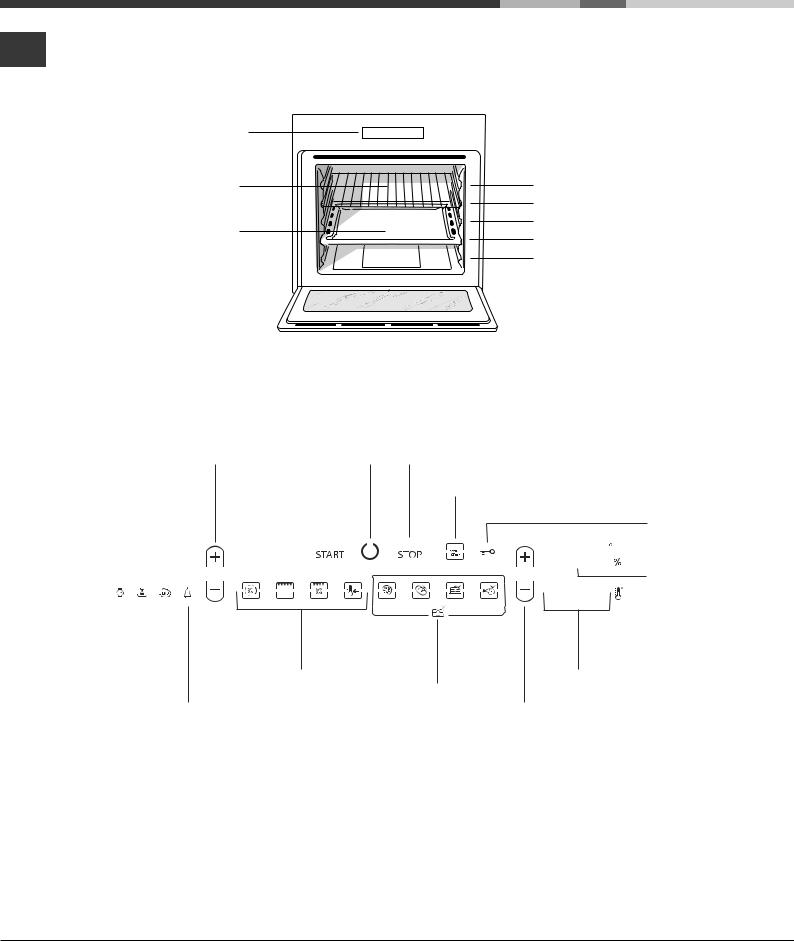
Description
of the appliance
Overall view
GB
Control panel |
GUIDES for the |
|
|
sliding racks |
|
GRILL |
position 5 |
|
|
position 4 |
|
DRIPPING PAN |
position 3 |
|
position 2 |
||
|
||
|
position 1 |
Control panel
TIME ADJUSTMENT |
CONTROL PANEL |
STOP |
|
|
|
|
|
|
|
|
|
|
|
|
|
|
||||||||||||
|
|
|
|
|
|
|
|
buttons |
POWER |
|
|
|
|
|
|
|
|
|
|
|
|
|
|
|
|
|
||
|
|
|
TIME |
|
|
|
|
button |
|
|
FAST CLEAN |
|||||||||||||||||
|
|
|
|
|
|
|
START |
|
|
|
||||||||||||||||||
|
display |
|
|
|
|
|
|
|
selector |
|
|
|
|
|
|
|
|
|
|
|
|
|
|
|||||
|
|
|
|
|
|
|
|
|
|
|
|
|
|
|
|
|
|
|
|
|
|
DOOR LOCK |
||||||
|
|
|
|
|
|
|
|
|
|
|
|
|
|
|
|
|
|
|
|
|
|
|
|
|
|
|
|
|
|
|
|
|
|
|
|
|
|
|
|
|
|
|
|
|
|
|
|
|
|
|
|
|
|
|
|
|
indicator |
|
|
|
|
|
|
|
|
|
|
|
|
|
|
|
|
|
|
|
|
|
|
|
|
|
|
|
|
|
|
|
|
|
|
|
|
|
|
|
|
|
|
|
|
|
|
|
|
|
|
|
|
|
|
|
|
|
TEMPERATURE |
|
|
|
|
|
|
|
|
|
|
|
|
|
|
|
|
|
|
|
|
|
|
|
|
|
|
|
|
|
|
|
|
|
|
|
|
|
|
|
|
|
|
|
|
|
|
|
|
|
|
|
|
|
|
|
|
|
|
|
|
|
|
|
|
|
|
|
|
|
|
|
|
|
|
|
|
|
|
|
|
|
|
|
|
|
|
|
|
|
|
|
|
|
|
|
|
|
|
|
|
|
|
|
|
|
|
|
|
|
|
|
|
|
|
|
display |
|
|
|
|
|
|
|
|
|
|
|
|
|
|
|
|
|
|
|
|
|
|
|
||||||
|
|
|
|
|
|
|
|
|
|
|
|
|
|
|
|
|
|
|
|
|
|
|
|
|
|
|
|
|
|
|
|
|
|
|
|
|
|
|
MANUAL |
AUTOMATIC |
|
|
|
|
|
|
|
|
CURRENT PREHEATING |
||||||||
|
|
|
|
|
|
|
|
|
COOKING MODE |
COOKING |
|
|
|
|
|
|
|
|
TEMPERATURE |
|||||||||
|
|
|
|
|
|
|
|
|
|
icons |
MODE |
|
|
|
|
|
|
|
|
indicator lights |
||||||||
CLOCK |
|
|
|
|
|
|
|
TIMER |
|
|
icons |
TEMPERATURE |
||||||||||||||||
|
|
|
|
|
|
|
|
|
|
|
|
|||||||||||||||||
icon |
|
|
|
|
|
|
|
icon |
|
|
|
|
|
adjustment |
||||||||||||||
|
|
|
|
|
|
|
|
|||||||||||||||||||||
DURATION |
|
|
|
|
COOKING END TIME |
|
|
|
|
|
|
|
|
|
|
|
|
|
|
|
|
|
||||||
|
icon |
|
|
|
|
icon |
|
|
|
|
|
|
|
|
|
|
|
|
|
|
|
|
|
|
|
|||
|
|
|
|
|
|
|
|
|
|
|
|
|
|
|
|
|
|
|
|
|
|
|||||||
4

Start-up and use
The first time you use your appliance, heat the empty oven with its door closed at its maximum temperature for at least half an hour. Ensure that the room is well ventilated before switching the oven off and opening the oven door. The appliance may emit a slightly unpleasant odour caused by protective substances used during the manufacturing process burning away.
The “Control panel lock” and “DEMO mode” can be activated/deactivated even when the control panel is switched off.
Control panel lock
To lock the oven controls, press the and
and buttons for 5 seconds. A buzzer sounds and the TEMPERATURE display shows “r-0”.
buttons for 5 seconds. A buzzer sounds and the TEMPERATURE display shows “r-0”.
Press again to unlock the controls. The “STOP” button is always active.
Demo mode
The oven can operate in DEMO mode: all heating elements are deactivated, and controls remain operative.
To activate the DEMO mode, press the ,
, , and
, and  buttons simultaneously.
buttons simultaneously.
To deactivate the DEMO mode, press the  ,
, ,
, 
and buttons at the same time. A buzzer sounds and the display shows “demo off”.
buttons at the same time. A buzzer sounds and the display shows “demo off”.
Setting the clock and timer
After the appliance has been connected to the mains, or
after a blackout, the  button will begin to blink. To set the time:
button will begin to blink. To set the time:
1.Set the hour figure within 8 seconds using the “+” and “-” buttons on the right hand side.
2.Press the  button again.
button again.
3.Adjust the minutes using the “+” and “-” buttons on the right hand side.
4.Wait at least 8 seconds for the setting to be
memorised, or press the  button again.
button again.
To make any necessary changes, switch on the control
panel by pressing the button, then press the
button, then press the  button and follow the described procedure.
button and follow the described procedure.
When the set time has elapsed, a buzzer will sound. The buzzer will automatically stop after 6 seconds or when any active symbol on the control panel is pressed.
To set the timer, press button  and repeat the steps
and repeat the steps
described to set the clock. The  button indicates that the timer is active.
button indicates that the timer is active.
The timer does not switch the oven on or off.
GB
Starting the oven
1.Switch the control panel on by pressing the button.
button.
2.Press the button corresponding to the desired cooking mode. The displays show the time and temperature of the selected cooking mode.
3.Press the “START” button to begin cooking.
4.The oven will begin its preheating phase, and the current preheating temperature indicator lights turn red. The temperature may be changed by pressing the “+” and “-” buttons on the right hand side of the control panel.
5.When the preheating stage is complete, a buzzer sounds and all current preheating temperature indicator lights are illuminated: place the food in the oven.
6.During cooking it is always possible to:
-Change the temperature by pressing the “+” and “-” buttons on the right hand side of the control panel.
-Set the cooking duration (see Cooking Modes).
-Press “STOP” to interrupt cooking.
7.The oven switches off automatically after two hours: this default time is set for all cooking modes for safety reasons.
The cooking duration may be changed (see Cooking Modes).
8.If a blackout occurs, while the oven was already operating, an automatic system within the appliance will reactivate the cooking mode from where it was interrupted as long as the temperature has not dropped below a certain level. Programmed cooking modes which have not started will not be restored and must be reprogrammed.
There is no preheating stage for the BARBECUE mode.
Never put objects directly on the bottom of the oven; this will avoid the enamel coating being damaged.
Always place cookware on the rack(s) provided.
Cooling ventilation
In order to cool down the external temperature of the oven, a cooling fan generates a stream of air which escapes between the oven control panel and the oven door. At the beginning of the FAST CLEAN mode, the cooling fan operates at low speed.
Once the cooking has been completed, the cooling fan continues to operate until the oven has cooled down sufficiently.
Oven light
When the oven is not in operation, the lamp can be switched on at any time by opening the oven door.
5
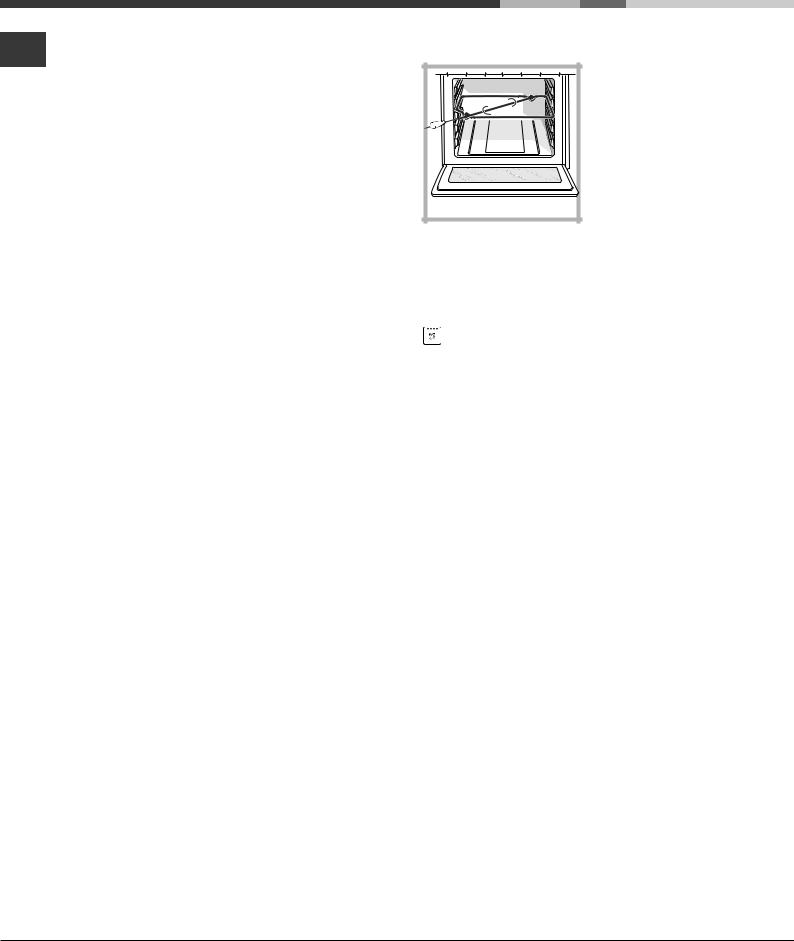
Cooking modes
Manual cooking modes
GB
All cooking modes have a default cooking temperature which may be adjusted manually between 40°C and 250°C as desired.
In the BARBECUE mode, the default power level value is indicated as a percentage (%) and may also be adjusted manually.
 MULTILEVEL mode
MULTILEVEL mode
All heating elements and the fan are activated. Since the heat remains constant throughout the oven, the air cooks and browns food in a uniform manner. A maximum of two racks may be used at the same time.
 BARBECUE mode
BARBECUE mode
The top heating element and the rotisserie spit (where present) are activated. By pressing the “+” and “-” buttons on the left hand side of the control panel, the power levels that may be set will appear on the TEMPERATURE display; these range between 5% and 100%. The high and direct temperature of the grill is recommended for food that requires high surface temperature. Always cook in this mode with the oven door closed.
 GRATIN mode
GRATIN mode
The top heating element and the rotisserie spit (where present) are activated and the fan begins to operate. During part of the cycle the circular heating element is also activated. This combination of features increases the effectiveness of the unidirectional thermal radiation of the heating elements through forced circulation of the air throughout the oven.
This helps prevent food from burning on the surface and allows the heat to penetrate right into the food. Always cook in this mode with the oven door closed.
 LOW TEMPERATURE modes
LOW TEMPERATURE modes
This type of cooking can be used for proving, defrosting, preparing yoghurt and heating dishes at the required speed. The temperature options are: 40, 65, 90 °C.
Spit roast (only available in certain models)
To operate the rotisserie spit (see diagram) proceed as follows:
1.Place the dripping pan in position 1.
2.Place the rotisserie support in position 3 and insert the spit into the hole provided on the back panel of the oven.
3.Start the spit roast function by selecting the or
or
modes.
When the mode is activated, the rotisserie spit will stop if the door is opened.
mode is activated, the rotisserie spit will stop if the door is opened.
Automatic cooking modes
The temperature and cooking duration are pre-set values, guaranteeing a perfect result every time -
automatically. These values cannot be adjusted and use the C.O.P.® (Programmed Optimal Cooking) system. The cooking cycle stops automatically and the oven indicates when the dish is cooked. You may start cooking whether the oven has been preheated or not.
When the cooking stage has been reached, the oven buzzer sounds.
Do not open the oven door as this will disrupt the duration and temperature.
 MEAT mode
MEAT mode
Use this function to cook beef, pork and lamb. Place the meat inside the oven while it is still cold. The dish may also be placed in a preheated oven.
 BAKED CAKES mode
BAKED CAKES mode
This function is ideal for cooking desserts which are made using natural yeast, baking powder and desserts which contain no yeast. Place the dish in the oven while it is still cold. The dish may also be placed in a preheated oven.
6

 PIZZA mode
PIZZA mode
Use this function to make pizza. Please see the following chapter for further details.
 BREAD mode
BREAD mode
Use this function to make bread. Please see the following chapter for further details.
 PIZZA mode
PIZZA mode
To obtain the best results, we recommend that you carefully observe the instructions below:
•Follow the recipe.
•The weight of the dough should be between 500 g and 700 g.
•Lightly grease the dripping pan.
Recipe for PIZZA:
1 dripping pan on a low shelf level, hot or cold oven Recipe for 3 pizzas weighing approximately 550 g: 1000 g flour, 500 ml water, 20 g salt, 20 g sugar, 100 ml olive oil, 20 g fresh yeast (or 2 sachets of powder yeast)
•Leavening at room temperature: 1 hour.
•Place inside hot or cold oven.
•Start the  PIZZA cooking mode.
PIZZA cooking mode.
BREAD mode |
GB |
To obtain the best results, we recommend that you |
|
|
|
carefully observe the instructions below: |
|
•Follow the recipe.
•Do not exceed the maximum weight of the dripping pan.
•Remember to pour 100 ml of cold water into the baking tray in position 5.
•The dough must be left to rise at room temperature for 1 – 1 ½ hours (depending on the room temperature) or until the dough has doubled in size.
Recipe for BREAD:
1 Dripping pan holding 1000 g Max, lower level
2 Dripping pans each holding 1000 g Max, medium and lower levels
Recipe for 1000 g of dough: 600 g flour, 360 g water, 11g salt, 25 g fresh yeast (or 2 sachets of powder yeast)
Method:
•Mix flour and salt in a large bowl.
•Dilute yeast in lukewarm water (approximately 35 degrees).
•Make a small well in the mound of flour.
•Pour in water and yeast mixture.
•Knead dough by stretching and folding it over itself with the palm of your hand for 10 minutes until it has a uniform consistency and is not too sticky.
•Ball and cover the dough with plastic wrap and leave it to leaven at room temperature for 1 – 1 ½ hours (until it has doubled in size).
•Cut the dough into equal sized loaves.
•Place them in the dripping pan on oven paper.
•Cover the loaves with flour.
•Make incisions on the loaves.
•Remember to pour 100 ml of cold water into the baking tray in position 5. For cleaning purposes, we recommend the use of water and vinegar.
•Place the loaves inside the oven while it is still cold.
•Start the  BREAD cooking mode.
BREAD cooking mode.
•Once baked, leave the loaves on one of the grill racks until they have cooled completely.
7

Programming cooking
GB
A cooking mode must be selected before programming can take place.
Programming the duration
Press the button, then:
button, then:
1.Adjust the time using the “+” and “-” buttons on the left hand side of the control panel.
2.Press the button to memorise the setting.
button to memorise the setting.
3.Press the “START” button to confirm the programming process.
4.When the set time has elapsed, END appears on the TEMPERATURE display and a buzzer sounds.
• For example: it is 9:00 a.m. and a time of 1 hour and 15 minutes is programmed. The programme will stop automatically at 10:15 a.m.
Programming delayed cooking
1.Press the button and repeat steps 1 and 2 as described.
button and repeat steps 1 and 2 as described.
2.Then press the  button and set the end time using the “+” and “-” buttons on the left hand side of the control panel.
button and set the end time using the “+” and “-” buttons on the left hand side of the control panel.
3.Press the  button to memorise the setting.
button to memorise the setting.
4.Press the “START” button to confirm the programming process.
5.When the selected time has elapsed, END appears on the TEMPERATURE display and a buzzer sounds.
• For example: it is 9:00 a.m. and a time of 1 hour and 15 minutes is programmed and the end time is set to 12:30. The programme will start automatically at 11:15 a.m.
Programming has been set when the and
and  buttons flash. The TIME and DURATION displays show the end time and the duration alternately.
buttons flash. The TIME and DURATION displays show the end time and the duration alternately.
To cancel a programming procedure press the “STOP” button.
When selecting a cooking mode, the button is activated whereas the
button is activated whereas the  button is not. When setting the cooking time, the
button is not. When setting the cooking time, the  button is illuminated and delayed cooking can be programmed.
button is illuminated and delayed cooking can be programmed.
Practical cooking advice
Do not place racks in position 1 and 5 during fanassisted cooking. This is because excessive direct heat can burn temperature sensitive foods.
In the BARBECUE and GRATIN cooking modes, particularly when using the rotisserie spit, place the dripping pan in position 1 to collect cooking residues (fat and/or grease).
MULTILEVEL
•Use positions 2 and 4, placing the food which requires more heat on 2.
•Place the dripping pan on the bottom and the rack on top.
BARBECUE
•Place the grill rack in position 3 or 4 and place the food in the centre of the rack.
•We recommend that the power level is set to maximum. The top heating element is regulated by a thermostat and may not always operate constantly.
PIZZA
•Use a light aluminium pizza pan. Place it on the rack provided.
For a crispy crust, do not use the dripping pan as it prevents the crust from forming by extending the total cooking time.
•If the pizza has a lot of toppings, we recommend adding the mozzarella cheese on top of the pizza halfway through the cooking process.
8
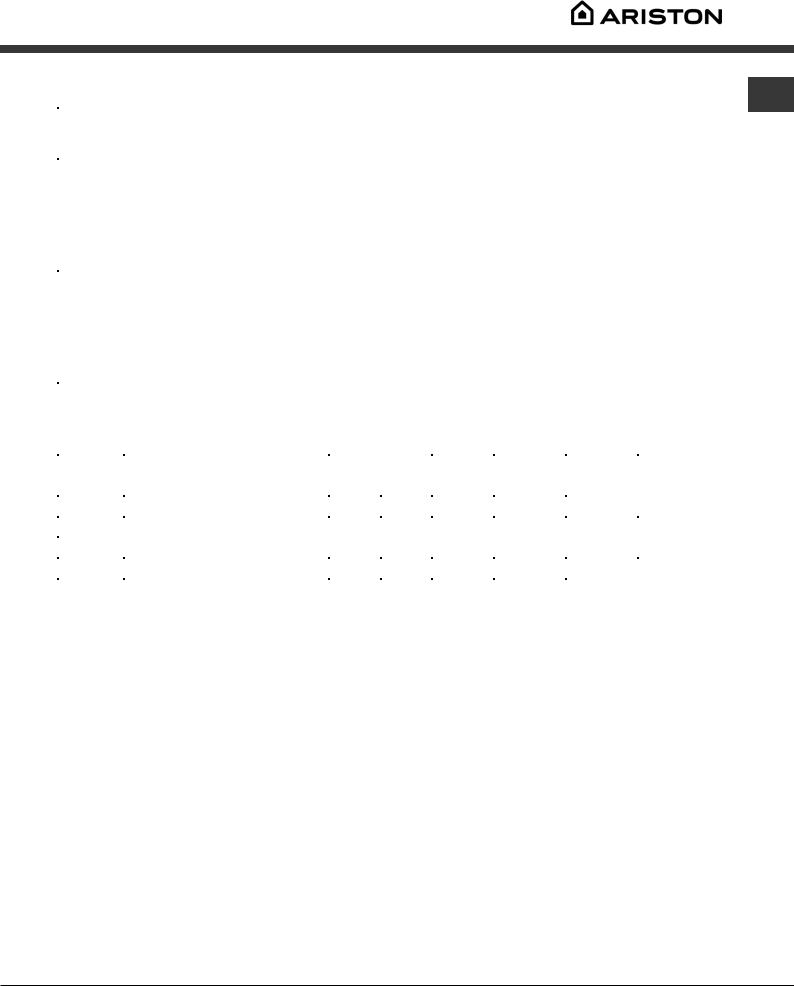
Cooking advice table
GB
&RRNLQJ |
)RRGV |
:HLJKW |
5DFN SRVLWLRQ |
3UHKHDWLQJ |
5HFRPPHQGHG |
&RRNLQJ GXUDWLRQ |
||
PRGHV |
|
LQ NJ |
|
|
|
|
WHPSHUDWXUH |
PLQXWHV |
|
|
|
VWDQGDUG |
|
VOLGLQJ JXLGH |
|
ƒ& |
|
|
|
|
|
|
|
|
||
|
|
|
JXLGH UDLOV |
|
UDLOV |
|
|
|
0XOWLOHYHO |
3L]]D RQ UDFNV |
|
DQG |
|
DQG |
<HV |
|
|
|
3LHV RQ WZR UDFNV FDNHV RQ UDFNV |
|
DQG |
|
DQG |
<HV |
|
|
|
6SRQJH FDNH RQ UDFNV RQ WKH GULSSLQJ SDQ |
|
DQG |
|
DQG |
<HV |
|
|
|
5RDVW FKLFNHQ SRWDWRHV |
|
DQG |
|
DQG |
<HV |
|
|
|
/DPE |
|
|
|
|
<HV |
|
|
|
0DFNHUHO |
|
RU |
|
|
<HV |
|
|
|
/DVDJQH |
|
|
|
|
<HV |
|
|
|
&UHDP SXIIV RQ UDFNV |
|
DQG |
|
DQG |
<HV |
|
|
|
%LVFXLWV RQ UDFNV |
|
DQG |
|
DQG |
<HV |
|
|
|
&KHHVH SXIIV RQ UDFNV |
|
DQG |
|
DQG |
<HV |
|
|
|
6DYRXU\ SLHV |
|
DQG |
|
DQG |
<HV |
|
|
%DUEHFXH |
0DFNHUHO |
|
|
|
|
1R |
|
|
|
6ROH DQG FXWWOHILVK |
|
|
|
|
1R |
|
|
|
6TXLG DQG SUDZQ NHEDEV |
|
|
|
|
1R |
|
|
|
&RG ILOOHW |
|
|
|
|
1R |
|
|
|
*ULOOHG YHJHWDEOHV |
|
RU |
|
RU |
1R |
|
|
|
9HDO VWHDN |
|
|
|
|
1R |
|
|
|
6DXVDJHV |
|
|
|
|
1R |
|
|
|
+DPEXUJHUV |
RU |
|
|
|
1R |
|
|
|
7RDVWHG VDQGZLFKHV RU WRDVW |
RU |
|
|
|
1R |
|
|
|
6SLW URDVW FKLFNHQ XVLQJ URWLVVHULH VSLW ZKHUH SUHVHQW |
|
|
|
|
1R |
|
|
|
6SLW URDVW ODPE XVLQJ URWLVVHULH VSLW ZKHUH SUHVHQW |
|
|
|
|
1R |
|
|
*UDWLQ |
*ULOOHG FKLFNHQ |
|
|
|
|
1R |
|
|
|
&XWWOHILVK |
|
|
|
|
1R |
|
|
|
6SLW URDVW FKLFNHQ XVLQJ URWLVVHULH VSLW ZKHUH SUHVHQW |
|
|
|
|
1R |
|
|
|
6SLW URDVW GXFN XVLQJ URWLVVHULH VSLW ZKHUH SUHVHQW |
|
|
|
|
1R |
|
|
|
5RDVW YHDO RU EHHI |
|
|
|
|
1R |
|
|
|
5RDVW SRUN |
|
|
|
|
1R |
|
|
|
/DPE |
|
|
|
|
1R |
|
|
/RZ |
'HIURVWLQJ |
|
RU |
|
|
1R |
|
|
WHPSHUDWXUH |
3URYLQJ |
|
RU |
|
|
1R |
|
|
|
'LVK KHDWLQJ |
|
RU |
|
|
1R |
|
|
|
3DVWHXULVDWLRQ |
|
RU |
|
|
1R |
|
|
$XWRPDWLF |
3L]]D VHH UHFLSH |
|
|
|
|
1R |
|
|
SL]]D |
)RFDFFLD EUHDG GRXJK |
|
|
|
|
1R |
|
|
$XWRPDWLF |
%UHDG VHH UHFLSH |
|
|
|
|
1R |
|
|
EUHDG |
|
|
|
|
|
|
|
|
$XWRPDWLF |
&DNHV PDGH XVLQJ OHDYHQHG GRXJK |
|
RU |
|
|
1R |
|
|
EDNHG FDNHV |
|
|
|
|
|
|
|
|
$XWRPDWLF |
5RDVWV |
|
RU |
|
|
1R |
|
|
URDVW |
|
|
|
|
|
|
|
|
7KH FRRNLQJ WLPHV OLVWHG DERYH DUH LQWHQGHG DV JXLGHOLQHV RQO\ DQG PD\ EH PRGLILHG DFFRUGLQJ WR SHUVRQDO WDVWHV 2YHQ SUHKHDWLQJ WLPHV DUH VHW DV VWDQGDUG DQG PD\ QRW EH PRGLILHG PDQXDOO\
9

Precautions and tips
This appliance has been designed and
GB manufactured in compliance with international safety standards. The following warnings are provided for safety reasons and must be read carefully.
General safety
•The appliance was designed for domestic use inside the home and is not intended for commercial or industrial use.
•The appliance must not be installed outdoors, even in covered areas. It is extremely dangerous to leave the appliance exposed to rain and storms.
•When moving or positioning the appliance, always use the handles provided on the sides of the oven.
•Do not touch the appliance with bare feet or with wet or damp hands and feet.
•The appliance must be used by adults only for the preparation of food, in accordance with the instructions provided in this booklet.
•Do not touch the heating elements and parts of the oven door when the appliance is in use; these parts become extremely hot. Keep children well away from the appliance.
•Ensure that the power supply cables of other electrical appliances do not come into contact with the hot parts of the oven.
•If the appliance breaks down, under no circumstances should you attempt to perform the repairs yourself. Repairs carried out by inexperienced persons may cause injury or further malfunctioning of the appliance. Contact a Service Centre (see Assistance).
•Do not rest heavy objects on the open oven door.
Disposal
•When disposing of packaging material: observe local legislation so that the packaging may be reused.
•The European Directive 2002/96/EC relating to Waste Electrical and Electronic Equipment (WEEE) states that household appliances should not be disposed of using the normal solid urban waste cycle. Exhausted appliances should be collected separately in order to optimise the cost of re-using and recycling the materials inside the machine, while preventing potential damage to the atmosphere and to public health. The crossed-out dustbin is marked on all products to remind the owner of their obligations regarding separated waste collection.
For further information relating to the correct disposal of exhausted household appliances, owners may contact the public service provided or their local dealer.
•The openings used for the ventilation and dispersion of heat must never be covered.
•Always grip the oven door handle in the centre: the ends may be hot.
•Always use oven gloves when placing cookware in the oven or when removing it.
•Do not use aluminium foil to line the bottom of the oven.
•Do not place flammable materials in the oven: If the appliance is switched on accidentally, it could catch fire.
•When unplugging the appliance, always pull the plug from the mains socket; do not pull on the cable.
•Never perform any cleaning or maintenance work without having disconnected the appliance from the electricity mains.
Respecting and conserving the environment
•You can help to reduce the peak load of the electricity supply network companies by using the oven in the hours between late afternoon and the early hours of the morning. The cooking mode programming options, the “delayed cooking” mode (see Cooking modes) and “delayed automatic cleaning” mode (see Care and Maintenance) in particular, enable the user to organise their time efficiently.
•Always keep the oven door closed when using the BARBECUE and GRATIN modes: This will achieve improved results while saving energy (approximately 10%).
•Check the door seals regularly and wipe them clean to ensure they are free of debris so that they adhere properly to the door, thus avoiding heat dispersion.
10
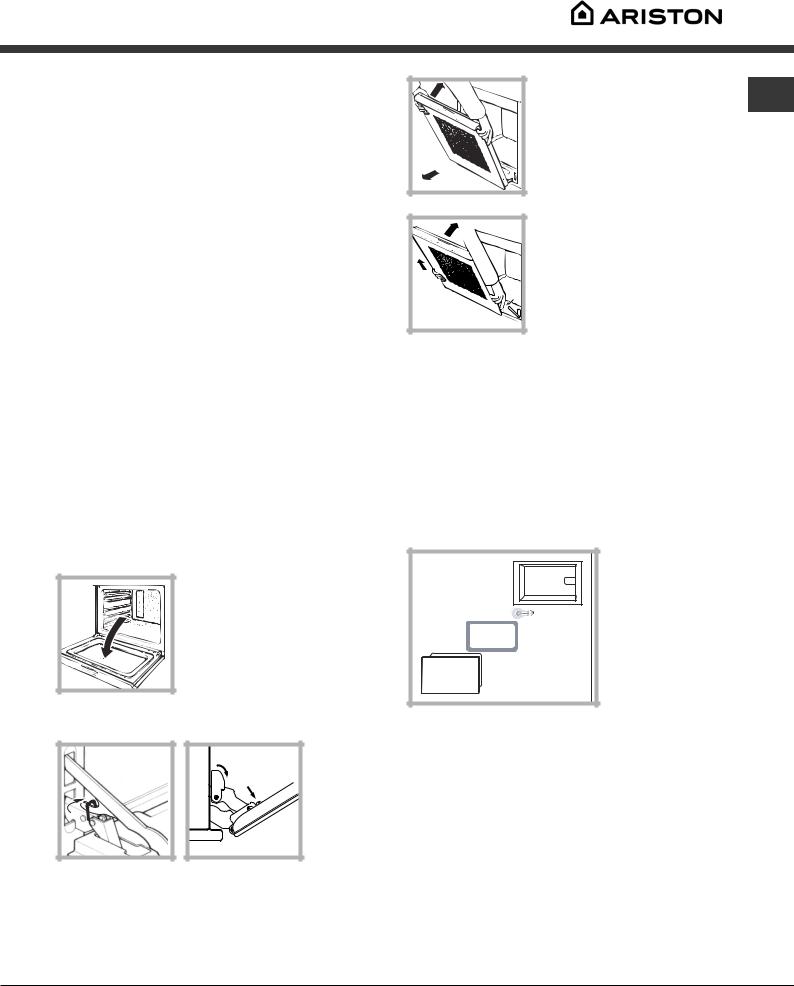
Care and maintenance
Switching the appliance off
Disconnect your appliance from the electricity supply before carrying out any work on it.
Cleaning the appliance
•The stainless-steel or enamel-coated external parts and the rubber seals may be cleaned using a sponge that has been soaked in lukewarm water and neutral soap. Use specialised products for the removal of stubborn stains. After cleaning, rinse and dry thoroughly. Do not use abrasive powders or corrosive substances.
•The inside of the oven should ideally be cleaned after each use, while it is still lukewarm. Use hot water and detergent, then rinse well and dry with a soft cloth. Do not use abrasive products.
•All accessories - with the exception of the sliding
racks - can be washed like everyday crockery, and are even dishwasher safe.
Never use steam cleaners or pressure cleaners on the appliance.
Cleaning the oven door
Clean the glass part of the oven door using a sponge and a non-abrasive cleaning product, then dry thoroughly with a soft cloth. Do not use rough abrasive material or sharp metal scrapers as these could scratch the surface and cause the glass to crack. For more thorough cleaning purposes, the oven door may be removed:
1. Open the oven door fully (see diagram).
2. Lift up and turn the small levers located on the two hinges (see diagram).
F |
With glass panel fitted to the inside of the door
3. Grip the door on the two
external sides and close it GB approximately half way. Pull
the door towards you, lifting it out of its slot (see diagram).
F |
3. (With glass panel fitted to the inside of the door) Grip the door on the two external sides and close it approximately half way. Unlock the door by pressing on the clamps F, then pull the door towards you lifting it out of its seat (see diagram).
To replace the door, reverse this sequence.
Inspecting the seals
Check the door seals around the oven regularly. If the seals are damaged, please contact your nearest Aftersales Service Centre (see Assistance). We recommend that the oven is not used until the seals have been replaced.
Replacing the light bulb
To replace the
oven light bulb:
Oven compartment
Lamp
Seal
Glass door
1.Remove the glass cover using a screwdriver.
2.Remove the light bulb and replace it with a similar one: Wattage 15 W, cap E 14.
Replace the glass cover, making sure the seal is positioned correctly (see diagram).
11

Automatic cleaning with the FAST CLEAN GB function
With the FAST CLEAN mode, the internal temperature of the oven reaches 500°C. The pyrolytic cycle is activated and burns away food and grime residues. Dirt is literally incinerated.
Keep children away from the appliance during the automatic cleaning cycle as surfaces may become very hot. Particles may ignite inside the oven due to the spontaneous combustion process. There is no cause for concern: this process is both normal and hazard-free.
Before initiating the FAST CLEAN mode:
•Remove large or coarse food residues from inside of the oven using a damp sponge. Do not use detergents.
•Remove all accessories.
•Do not place tea towels or pot holders over the oven handle.
If the oven is too hot, the pyrolytic cycle may not start. Wait for the oven to cool down.
The programme may only be started once the oven door has been closed.
To activate the FAST CLEAN mode, press the button and select the desired power level (the mode has three power levels which cannot be modified):
button and select the desired power level (the mode has three power levels which cannot be modified):
1.Economy (ECO): 1 hour
2.Normal (NOR): 1 hour and 30 minutes
3.Intensive (INT): 2 hours.
Safety devices
•The door is locked automatically as soon as the temperature exceeds a certain value.
•Should a malfunction occur, the heating elements will switch off.
•Once the oven door has been locked, you cannot change the duration and end time settings.
Programming is possible only after selecting the FAST CLEAN mode.
Programming delayed automatic cleaning
Press the  button, then:
button, then:
1.Adjust the time using the “+” and “-” buttons on the left hand side of the control panel.
2.Press the  button to memorise the setting.
button to memorise the setting.
3.Press the “START” button to confirm the programming process.
4.When the selected time has elapsed, END appears on the TEMPERATURE display and a buzzer sounds.
• For example: it is 9:00 a.m. and the Economy (ECO) FAST CLEAN mode level has been selected: default set time 1 hour. 12:30 is selected as the end time. The programme will start automatically at 11:30 a.m.
Programming has been set when the  and
and  buttons flash. The TIME and DURATION displays show the FAST CLEAN end time and its duration alternately.
buttons flash. The TIME and DURATION displays show the FAST CLEAN end time and its duration alternately.
To cancel a programming procedure press the “STOP” button.
Once the automatic cleaning cycle is over
You will have to wait until the temperature inside the oven has cooled down sufficiently before you can open the oven door. You will notice some white dust deposits on the bottom and the sides of your oven; remove these deposits with a damp sponge once the oven has cooled down completely. Alternatively, you can make use of the already heated oven, in which case it is not necessary to remove the deposits, they are completely harmless and will not affect your food in any way.
12

Assistance
Warning:
The appliance is fitted with an automatic diagnostic system which detects any malfunctions. Malfunctions are GB displayed by messages of the following type: “ER” followed by numbers.
Call for technical assistance should a malfunction occur.
Before calling for Assistance:
•Check whether you can fix the problem yourself.
•Restart the programme to check whether the malfunction has disappeared.
•If it has not, contact the Authorised Technical Assistance Service.
Never use the services of an unauthorised technician.
Please have the following information to hand:
•The message displayed on the TEMPERATURE display.
•The appliance model (Mod.).
•The serial number (S/N).
The latter two pieces of information can be found on the data plate located on the appliance.
13

Bedienungsanleitung
GB |
|
DE |
|
DK |
|
|
|
|
|
|
|
English,1 |
Deutsch, 14 |
Dansk, 27 |
|||
|
|
|
|
|
|
NO |
|
SE |
|
|
|
|
|
|
|
|
|
Norsk, 40 |
Svenska, 53 |
|
|
||
FZ 1021 P.1 NE
FZ 1021 P.1 IX NE
BACKOFEN
Inhaltsverzeichnis
DE
Installation, 15-16
Aufstellung
Elektroanschluss
Typenschild
Beschreibung des Gerätes, 17
Geräteansicht
Bedienfeld
Inbetriebsetzung und Gebrauch, 18
Sperre der Schaltelemente DEMO-Modus
Einstellung von Uhr und Kurzzeitwecker Inbetriebsetzung des Backofens
Programme, 19-22
Manuelle Garprogramme
Automatik-Garprogramme
Garzeit-Programmierung
Praktische Back-/Brathinweise
Back-/Brattabelle
Vorsichtsmaßregeln und Hinweise, 23
Allgemeine Sicherheit Entsorgung
Energie sparen und Umwelt schonen
Reinigung und Pflege, 24-25
Abschalten Ihres Gerätes vom Stromnetz
Reinigung Ihres Gerätes
Reinigung der Backofentür
Lampenaustausch
Automatische Reinigung FAST CLEAN
Kundendienst, 26
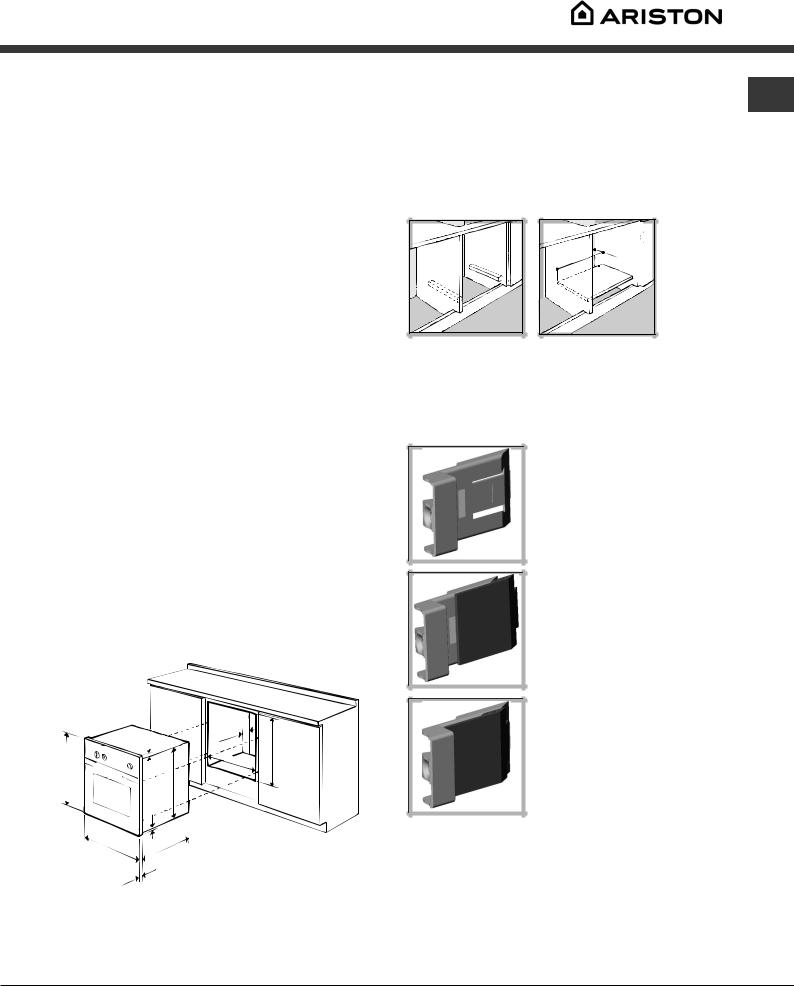
Installation
Bewahren Sie diese Bedienungsanleitung bitte sorgfältig auf, damit Sie sie jederzeit zu Rate ziehen können. Sorgen Sie dafür, dass sie im Falle eines Verkaufs, eines Umzugs oder einer Übergabe an einen anderen Benutzer das Gerät stets begleitet, damit auch der Nachbesitzer die Möglichkeit hat, darin nachschlagen zu können.
Lesen Sie bitte die nachfolgenden Hinweise aufmerksam durch. sie liefern wichtige Informationen hinsichtlich der Installation, des Gebrauchs und der Sicherheit.
Aufstellung
Verpackungsmaterial ist kein Spielzeug für Kinder. Es ist entsprechend den Vorschriften zur getrennten Müllsammlung zu entsorgen (siehe Vorsichtsmaßregeln und Hinweise).
Die Installation ist gemäß den vorliegenden Anweisungen und von Fachpersonal durchzuführen. Jede unsachgemäße Installation kann Menschen und Tiere gefährden oder Sachschaden verursachen.
Einbau
Um eine einwandfreie Betriebsweise des Gerätes zu gewährleisten, muss der Umbauschrank folgende Eigenschaften aufweisen:
•Die an den Backofen angrenzenden Schrankwände müssen aus hitzebeständigem Material gefertigt sein.
•Bei Möbeln aus Furnierholz muss der verwendete Leim einer Temperatur von 100°C standhalten.
•Für den Einbau des Backofens in einen
Unterschrank (siehe Abbildung) oder in einen
Hochschrank, muss das entsprechende Möbel über folgende Abmessungen verfügen:
Belüftung
DE
Um eine einwandfreie Belüftung zu gewährleisten, muss die Rückwand des Schrankumbaus abgenommen werden. Der Backofen sollte möglichst so installiert werden, dass er auf zwei Holzleisten oder aber auf einer durchgehenden Fläche aufliegt, die über einen Ausschnitt von mindestens 45 x 560 mm verfügt (siehe Abbildungen).
. |
45 |
mm |
mm |
|
|
|
. |
|
560 |
|
|
Zentrierung und Befestigung
Bringen Sie die 4 seitlich am Backofen befindlichen Klampen mit den 4 Löchern des Rahmens in Übereinstimmung. Achten Sie dabei darauf, dass bei einer Stärke der Umbauschrankwand von:
20 mm: der bewegliche Teil der Klampe abgenommen wird (siehe Abbildung);
18 mm: die erste, werkseitig bereits angebrachte Rille genutzt wird (siehe Abbildung);
mm.23 |
. |
mm. |
|
mm |
|
|
45 |
|
mm.595 |
|
|
mm.567 |
558 |
mm. |
593 |
|
|
|
||||
|
|
|
|
|
|
|
|
595 |
|
5 mm. |
|
|
|
|
mm. |
. |
|
|
|
|
|
|
mm |
|
|
|
|
|
|
|
545 |
|
|
|
|
|
. |
|
|
|
|
|
|
mm |
|
|
|
|
|
24 |
|
|
|
|
|
Nach dem Einbau des Gerätes muss eine Berührung mit den Elektroteilen ausgeschlossen sein.
Die auf dem Typenschild enthaltenen Verbrauchsangaben wurden bei dieser Art der Installation ermittelt.
16 mm: die zweite Rille genutzt wird (siehe Abbildung).
Befestigung des Gerätes am Möbel: Öffnen Sie die Backofentür und schrauben Sie die 4 Holzschrauben in die 4 im Backofenrahmen vorgesehenen Löcher ein.
Alle zum Schutz dienenden Teile müssen so befestigt werden, dass ein Entfernen derselben ohne Zuhilfenahme eines Werkzeugs nicht möglich ist.
15
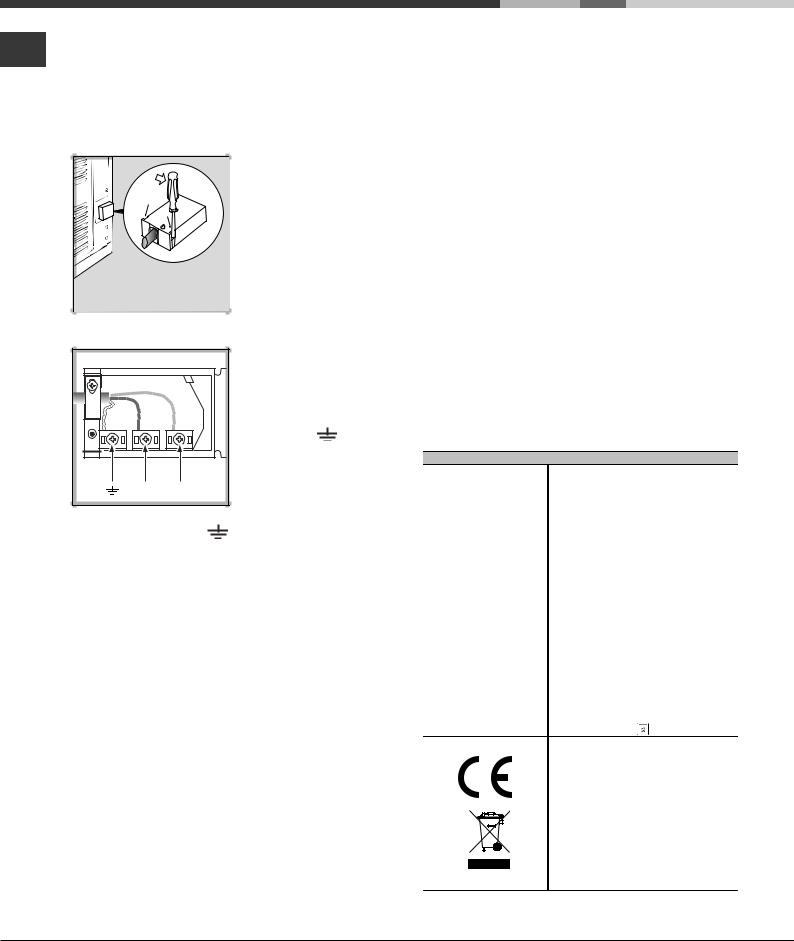
Elektroanschluss
DE
Die mit einem Dreileiterkabel ausgerüsteten Backöfen sind für den Betrieb mit Wechselstrom bei der auf dem Typenschild (befindlich auf dem Gerät) angegebenen Spannung und Frequenz ausgelegt (siehe unten).
Anschluss des Netzkabels
1. Öffnen Sie das Klemmengehäuse, indem Sie unter Zuhilfenahme eines Schraubenziehers die seitlichen Zungen des Klemmengehäusedeckels anheben. Ziehen Sie den Deckel ab (siehe Abbildung).
|
|
2. Installation des |
|
|
|
Netzkabels: Schrauben |
|
|
|
Sie die Schraube der |
|
|
|
Kabelklemme sowie die |
|
|
|
drei Schrauben der |
|
|
|
Kontakte L-N- |
heraus. |
|
|
Befestigen Sie die Drähte |
|
|
|
dann unter Beachtung der |
|
N |
L |
entsprechenden Farben |
|
unter den |
|
||
|
|
|
|
|
|
Schraubenköpfen: Blau |
|
(N), Braun (L), Gelb/Grün |
(siehe Abbildung). |
|
|
3.Befestigen Sie das Kabel in der entsprechenden Kabelklemme.
4.Schließen Sie den Deckel des Klemmengehäuses.
Anschluss des Versorgungskabels an das Stromnetz
Versehen Sie das Kabel mit einem Normstecker für die auf dem Typenschild angegebene Belastung (siehe nebenstehende Tabelle).
Wird das Gerät direkt an das Stromnetz angeschlossen, ist zwischen Stromnetz und Gerät ein allpoliger, der Last und den einschlägigen Vorschriften entsprechender Schalter mit einer Mindestöffnung der Kontakte von 3 mm zwischenzuschalten. (Der Erdleiter darf vom Schalter nicht unterbrochen werden.) Das Versorgungskabel muss so verlegt werden, dass es an keiner Stelle einer Temperatur ausgesetzt wird, die 50°C über der Raumtemperatur liegt.
Der Installateur ist für den ordnungsgemäßen elektrischen Anschluss sowie die Einhaltung der Sicherheitsvorschriften verantwortlich.
Vor dem Anschluss stellen Sie bitte sicher, dass:
•die Netzsteckdose geerdet ist und den gesetzlichen Bestimmungen entspricht;
•die Netzsteckdose für die auf dem Typenschild angegebene maximale Leistungsaufnahme des Gerätes ausgelegt ist (siehe unten);
•die Versorgungsspannung im Bereich der auf dem Typenschild angegebenen Werte liegt (siehe unten);
•die Netzsteckdose mit dem Netzstecker kompatibel ist. Sollte dies nicht der Fall sein, wechseln Sie bitte die Netzsteckdose oder den Netzstecker aus; verwenden Sie keine Verlängerungen und Mehrfachsteckdosen.
Netzkabel und Steckdose müssen bei installiertem Gerät leicht zugänglich sein.
Das Netzkabel darf nicht gebogen oder eingeklemmt werden.
Das Kabel muss regelmäßig kontrolliert werden und darf nur durch autorisiertes Fachpersonal ausgetauscht werden (siehe Kundendienst).
Der Hersteller lehnt jede Verantwortung ab, falls diese Vorschriften nicht eingehalten werden sollten.
7<3(16&+,/'
|
%UHLWH FP |
|
$EPHVVXQJHQ |
+|KH FP |
|
|
7LHIH FP |
|
1XW]YROXPHQ |
/LWHU |
|
|
%UHLWH FP |
|
$EPHVVXQJHQ |
+|KH FP |
|
|
7LHIH FP |
|
1XW]YROXPHQ |
/LWHU |
|
(OHNWULVFKHU |
6SDQQXQJ 9 a +] |
|
PD[LPDOH /HLVWXQJVDXIQDKPH |
||
$QVFKOXVV |
||
: |
||
|
||
|
5LFKWOLQLH (* •EHU GLH |
|
|
(WLNHWWLHUXQJ YRQ |
|
|
(OHNWUREDFN|IHQ |
|
(1(5*< /$%(/ |
1RUP (1 |
|
|
'HNODULHUWH
(QHUJLHYHUEUDXFKVNODVVH (U]ZXQJHQH .RQYHNWLRQ +HL]IXQNWLRQ hEHUEDFNHQ
'LHVHV *HUlW HQWVSULFKW GHQ IROJHQGHQ (* 5LFKWOLQLHQ
(:* YRP
1LHGHUVSDQQXQJ XQG QDFKIROJHQGHQ bQGHUXQJHQ
(:* YRP
HOHNWURPDJQHWLVFKH
9HUWUlJOLFKNHLW XQG QDFKIROJHQGHQ bQGHUXQJHQ
(:* YRP XQG QDFKIROJHQGHQ bQGHUXQJHQ
(*
0LW 9ROOJODVLQQHQW•U
2KQH DXV]LHKEDUH *OHLWVFKLHQHQ
16

Beschreibung des Gerätes
Geräteansicht
DE
Bedienfeld |
GLEITFÜHRUNGEN |
|
|
für die Einschübe |
|
Einschub BACKOFENROST |
Einschubhöhe 5 |
|
|
Einschubhöhe 4 |
|
Einschub FETTPFANNE |
Einschubhöhe 3 |
|
Einschubhöhe 2 |
||
|
||
|
Einschubhöhe 1 |
Bedienfeld
|
|
|
|
|
|
|
|
Tasten |
BEDIENFELD |
STOPP |
|
|
|
|
|
|
|
|
|
|
|
|
|
|
||||
ZEITREGULIERUNG |
|
ON |
|
|
|
|
|
|
|
|
|
|
|
|
|
|
|
|
|
|||||||||
|
Display |
|
|
|
|
|
START |
|
|
|
Wahl |
|
|
|
|
|
|
|
|
|
|
|
|
|
|
|||
|
|
|
|
|
|
|
|
|
|
|
|
|
|
|
|
|
|
|
|
|
|
|||||||
|
|
|
|
|
|
|
|
|
|
|
|
|
|
|
|
|
|
|
|
|
|
|
||||||
|
ZEITEN |
|
|
|
|
|
|
|
|
FAST CLEAN |
||||||||||||||||||
|
|
|
|
|
|
|
|
|
|
|||||||||||||||||||
|
|
|
|
|
|
|
|
|
|
|
|
|
|
|
|
|
|
|
|
|
|
|
|
|
|
|
|
Anzeige |
|
|
|
|
|
|
|
|
|
|
|
|
|
|
|
|
|
|
|
|
|
|
|
|
|
|
|
|
TÜRSPERRE |
|
|
|
|
|
|
|
|
|
|
|
|
|
|
|
|
|
|
|
|
|
|
|
|
|
|
|
|
|
|
|
|
|
|
|
|
|
|
|
|
|
|
|
|
|
|
|
|
|
|
|
|
|
|
|
|
|
Display |
|
|
|
|
|
|
|
|
|
|
|
|
|
|
|
|
|
|
|
|
|
|
|
|
|
|
|
|
|
|
|
|
|
|
|
|
|
|
|
|
|
|
|
|
|
|
|
|
|
|
|
|
|
|
|
|
|
|
|
|
|
|
|
|
|
|
|
|
|
|
|
|
|
|
|
|
|
|
|
|
|
|
|
|
|
|
|
|
|
|
|
|
|
|
|
|
|
|
|
|
|
|
|
|
|
|
|
|
|
|
|
|
|
|
|
TEMPERATUR |
|
|
|
|
|
|
|
|
|
|
|
|
|
|
|
|
|
|
|
|
|
|
|
|
|||||
|
|
|
|
|
|
|
|
|
|
|
|
|
|
|
|
|
|
|
|
|
|
|
|
|
|
|
|
|
|
|
|
|
|
|
|
|
|
Symboltaste |
|
|
|
|
|
|
|
|
|
|
|
Anzeigen der |
|||||||
|
|
|
|
|
|
|
|
|
MANUELLE |
|
|
|
|
|
|
|
|
|
|
|
AKTUELLEN |
|||||||
|
|
|
|
|
|
|
|
|
GARPROGRAMME |
|
|
|
|
|
|
|
|
|
|
|
GARRAUMTEMPERATUR |
|||||||
Symboltaste |
|
|
|
|
|
|
|
Symboltaste |
|
|
Symboltaste |
Einstellen der |
||||||||||||||||
|
|
|
|
|
|
|
|
|
AUTOMATIK- |
|||||||||||||||||||
UHR |
|
|
|
|
|
|
|
KURZZEITWECKER |
TEMPERATUR |
|||||||||||||||||||
|
|
|
|
|
|
|
GARPROGRAMME |
|||||||||||||||||||||
|
|
|
|
|
|
|
|
|
|
|
|
|
|
|
|
|
|
|
|
|
|
|
|
|
|
|||
Symboltaste |
|
|
|
|
|
Symboltaste |
|
|
|
|
|
|
|
|
|
|
|
|
|
|
|
|
|
|
|
|||
DAUER |
|
|
|
|
|
GARZEITENDE |
|
|
|
|
|
|
|
|
|
|
|
|
|
|
|
|
|
|
|
|||
|
|
|
|
|
|
|
|
|
|
|
|
|
|
|
|
|
|
|
|
|
||||||||
17
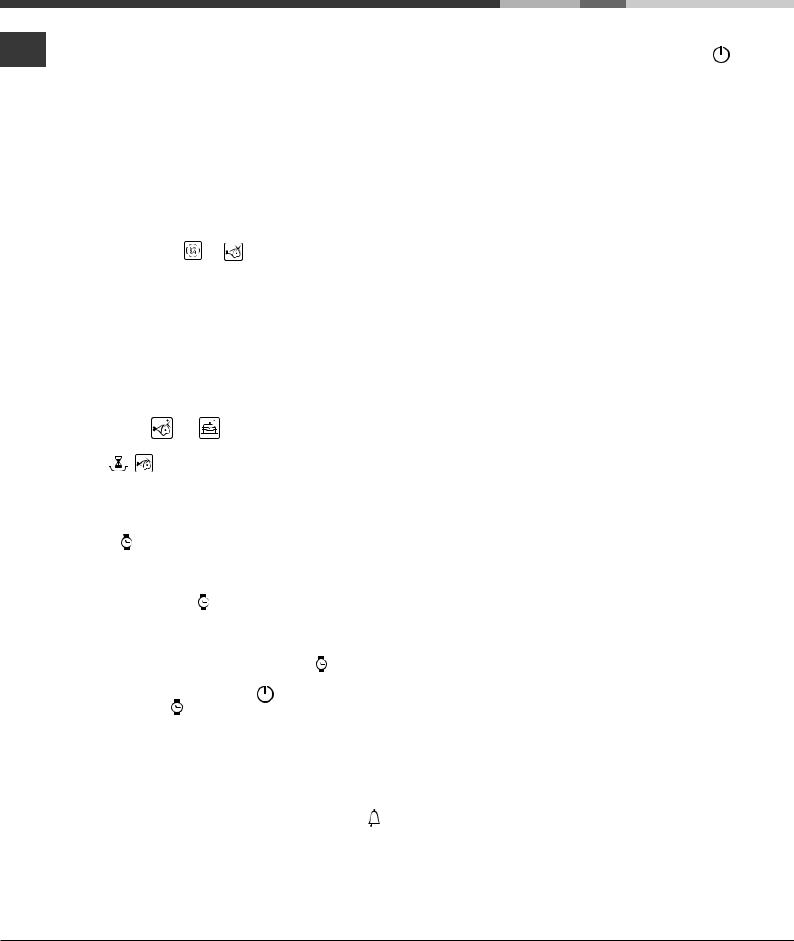
Inbetriebsetzung und Gebrauch
Bei erstmaliger Inbetriebnahme sollte der leere Backofen für DE etwa eine Stunde bei Höchsttemperatur und geschlossener
Backofentür in Betrieb genommen werden. Schalten Sie das Gerät dann aus, öffnen Sie die Backofentür und lüften Sie die Küche. Der bei diesem Vorgang entstehende Geruch wird durch das Verdunsten der zum Schutz des Backofens aufgetragenen Stoffe verursacht.
Die Funktionen “Sperre der Schaltelemente” und “DEMOModus” können auch bei ausgeschaltetem Bedienfeld aktiviert/deaktiviert werden.
SperrederSchaltelemente
Zur Sperrung der Backofen-Schaltelemente drücken Sie für 5 Sekunden auf die Tasten und . Es ertönt ein akustisches Signal und auf dem Display TEMPERATUR erscheint die Anzeige “r-0”. Durch erneutes Drücken werden die Schaltelemente wieder freigegeben. Die Taste “STOPP” bleibt immer aktiviert.
Demo-Modus
Der Backofen kann auch im Vorführmodus (DEMO) in Betrieb gesetzt werden: Während dieser Betriebsweise werden sämtliche Heizelemente deaktiviert, die Schaltelemente bleiben jedoch einsatzfähig.
Zur Aktivierung des DEMO-Modus drücken Sie gleichzeitig die
Tasten  ,
, , und
, und  .
.
Zur Deaktivierung des DEMO-Modus drücken Sie gleichzeitig auf  , , und
, , und  . Es ertönt ein akustisches Signal und auf dem Display erscheint die Anzeige „demo off“.
. Es ertönt ein akustisches Signal und auf dem Display erscheint die Anzeige „demo off“.
EinstellungvonUhrundKurzzeitwecker
Nach dem Netzanschluss oder nach einem Stromausfall blinkt die Taste .
Zur Einstellung der Uhrzeit:
1. Stellen Sie innerhalb von 8 Sekunden mittels der Tasten “+” und “-” (rechte Displayseite) die Stunden ein.
2. Drücken Sie die Taste erneut.
3.Stellen Sie mittels der Tasten “+” und “-” (rechte Displayseite) die Minuten ein.
4.Warten Sie bitte mindestens 8 Sekunden, um die Einstellung
zu speichern, oder drücken Sie erneut die Taste .
Um eventuelle Änderungen anzubringen schalten Sie das
Bedienfeld durch Drücken der Taste |
aus. Drücken Sie |
|
daraufhin die Taste |
und verfahren Sie gemäß obiger |
|
Anleitung. |
|
|
Nach Ablauf der für den Kurzzeitwecker eingestellten Zeit ertönt ein akustisches Signal, das nach einer Minute oder durch Drücken auf ein beliebiges aktiviertes Symbol verstummt.
Zur Einstellung des Kurzzeitweckers drücken Sie die Taste und befolgen Sie die zur Einstellung der Uhr beschriebene Vorgehensweise. Die Taste  zeigt an, dass der Kurzzeitwecker aktiviert wurde.
zeigt an, dass der Kurzzeitwecker aktiviert wurde.
Der Kurzzeitwecker steuert nicht das Einund Ausschalten des Backofens.
InbetriebsetzungdesBackofens
1.Schalten Sie das Bedienfeld durch Druck auf die Taste ein.
2.Drücken Sie auf die Taste der von Ihnen gewünschten Garfunktion. Auf dem Display wird die Garzeitdauer und die dem Garprogramm zugeordnete Temperatur angezeigt.
3.Drücken Sie die Taste „START“, um den Garvorgang einzuleiten.
4.Der Backofen schaltet auf Vorheizen; die Anzeigen der aktuellen Garraumtemperatur schalten auf Rot. Die Temperatur kann durch Drücken der “+” und “-” Tasten (rechte Seite des Displays) geändert werden.
5.Ein akustisches Signal und das Aufleuchten sämtlicher Anzeigen der aktuellen Garraumtemperatur zeigen an, dass die Vorheizphase abgeschlossen ist. Geben Sie die zu garenden Speisen in den Backofen.
6.Während des Garvorgangs sind folgende Einstellungen jederzeit möglich:
- die Änderung der Temperatur durch Drücken der “+” und “-” Tasten (rechte Seite des Displays);
- die Programmierung einer Garzeitdauer (siehe Programme); - ein Unterbrechen des Garvorgangs durch Betätigen der Taste “STOPP”.
7.Nach zwei Stunden schaltet sich der Backofen automatisch aus. Diese Zeit ist aus Sicherheitsgründen bei allen Garprogrammen voreingestellt.
Die Garzeitdauer kann verändert werden (siehe Programme).
8.Für den Fall eines Stromausfalls ist das Gerät mit einem System ausgestattet, welches das Programm wieder an dem Punkt aufnimmt, an dem es unterbrochen wurde. Noch auszuführende, vorprogrammierte Vorgänge hingegen werden bei Rückkehr der Stromversorgung nicht wiederhergestellt und müssen neu programmiert werden.
Das Programm GRILL sieht kein Vorheizen des Backofens vor.
Stellen Sie niemals Kochgeschirr auf dem Backofenboden ab, da dadurch das Email beschädigt werden könnte.
Stellen Sie Ihr Kochgeschirr stets auf den mit dem Gerät gelieferten Backofenrost.
Kühlluftgebläse
Um die Temperaturen an den äußeren Teilen des Backofens abzusenken, wird mit Hilfe eines Kühlluftgebläses ein Luftstrahl erzeugt, der zwischen dem Bedienfeld und der Backofentür austritt. Zu Beginn des Programms FAST CLEAN verfügt das Gebläse über eine niedrige Geschwindigkeit.
Nach Abschluss eines Garvorgangs bleibt das Gebläse solange in Betrieb, bis der Backofen ausreichend abgekühlt ist.
Backofenbeleuchtung
Bei ausgeschaltetem Backofen kann das Backofenlicht jederzeit durch Öffnen der Backofentür eingeschaltet werden.
18
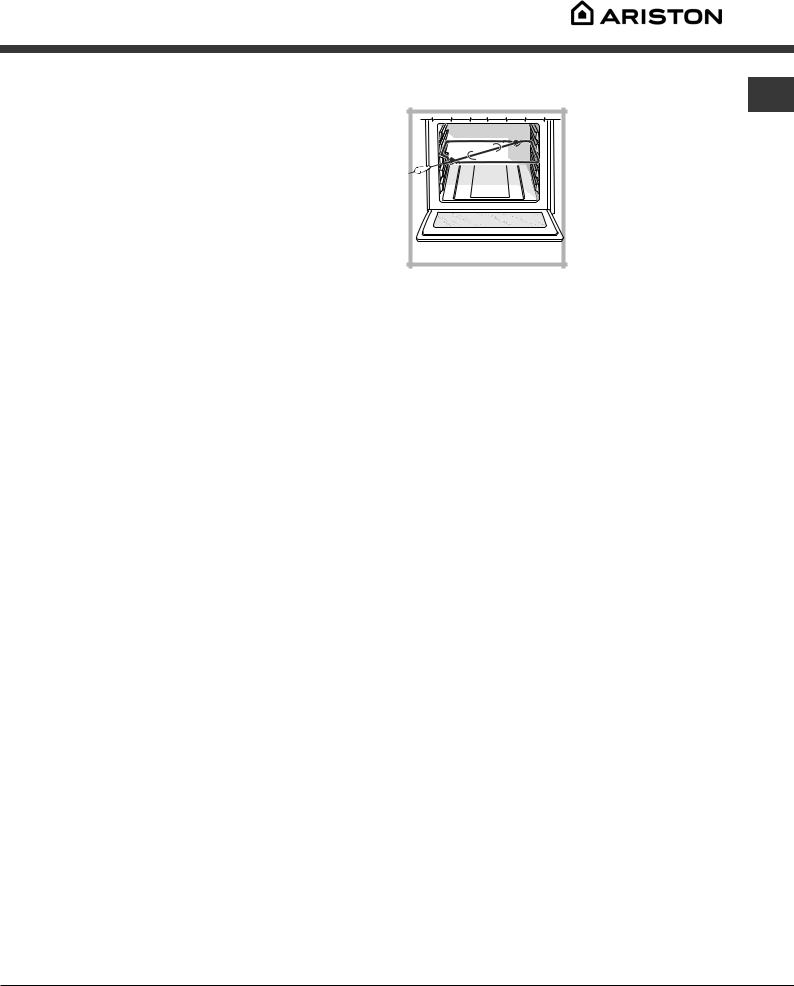
Programme
Manuelle Garprogramme
Für alle Programme ist eine Gartemperatur voreingestellt. Diese kann von Hand auf einen beliebigen Wert zwischen 40°C und 250°C verändert werden.
Bei dem Programm GRILL ist der voreingestellte Wert eine in % angegebene Leistungsstufe. Auch diese lässt sich manuell verändern.
 Programm ECHTE HEISSLUFT
Programm ECHTE HEISSLUFT
Alle Heizelemente schalten sich ein und das Gebläse wird in Betrieb genommen. Da die Hitze im gesamten Backofen konstant ist, werden die Speisen sehr gleichmäßig gegart und gebräunt. Es kann auf maximal zwei Einschubhöhen gleichzeitig gegart werden.
 Programm GRILL
Programm GRILL
Das obere Heizelement schaltet sich ein, und der Drehspieß (falls vorhanden) wird in Betrieb gesetzt. Durch Betätigen der Tasten “+” und “-” (linke Seite des Displays), werden auf dem Display TEMPERATUR die einstellbaren Leistungswerte angezeigt, die von 5% bis 100% reichen. Die sehr hohe Temperatur und die direkt auf das Grillgut gerichtete Hitze empfiehlt sich für Lebensmittel, die zur optimalen Garung einer hohen Temperatur auf der Oberseite bedürfen. Garen Sie bei geschlossener Backofentür.
 Programm ÜBERBACKEN
Programm ÜBERBACKEN
Das obere Heizelement und für eine gewisse Zeit auch das runde Heizelement schalten sich ein, und das Gebläse sowie der Drehspieß (falls vorhanden) werden in Betrieb gesetzt. Außer der einseitigen Strahlungshitze zirkuliert Heißluft im Innern des Backofens.
Hierdurch wird ein Verbrennen der Speisenoberflächen verhindert, und die Hitze dringt tiefer in die Speisen ein. Garen Sie bei geschlossener Backofentür.
 Programme NIEDRIGE TEMPERATUR
Programme NIEDRIGE TEMPERATUR
Diese Programme eignen sich zum Gären von Hefeteigen, zum Auftauen von Gefriergut, zur Bereitung von Yoghurt, zum mehr oder weniger schnellen Aufwärmen. Folgende Temperaturen können eingestellt werden: 40, 65, 90°C.
Drehspieß (nur bei einigen Modellen)
DE
Zur Inbetriebnahme des
Drehspießes (siehe
Abbildung) verfahren
Sie wie folgt:
1.Schieben Sie die Fettpfanne auf Einschubhöhe 1 ein;
2.Schieben Sie die Drehspießhalterung auf Einschubhöhe 3 ein und stecken Sie den Spieß in die entsprechende Öffnung der Backofenrückwand;
3.Setzen Sie den Drehspieß durch Wahl der
Programme oder
oder in Betrieb.
in Betrieb.
Ist das Programm  eingeschaltet, stoppt der Drehspieß, wenn die Tür geöffnet wird.
eingeschaltet, stoppt der Drehspieß, wenn die Tür geöffnet wird.
Automatik-Garprogramme
Temperatur und Garzeitdauer sind vorbestimmt und durch das System C.O.P.® (Cottura Ottimale Programmata – Programmierte optimale Garzeit) unveränderlich. Somit wird ein perfektes Ergebnis garantiert. Der Backvorgang wird automatisch unterbrochen; der Backofen signalisiert, wenn das Backgut gar ist. Das Backgut kann in den nicht vorgeheizten oder in den vorgeheizten Backofen geschoben werden.
Bei Erreichen der Garphase ertönt ein akustisches Signal.
Öffnen Sie die Backofentür bitte nicht. Sie verhindern dadurch, dass Dauer und Temperatur des Garvorgangs verfälscht werden.
 Programm BRATEN
Programm BRATEN
Verwenden Sie diese Funktion für Kalbs-, Schweineund Lammbraten. Schieben Sie das Gargut in den kalten Ofen. Es kann jedoch auch in den vorgeheizten Backofen gegeben werden.
19

DE |
Programm KUCHEN |
|
Diese Funktion ist ideal zum Backen von Kuchen mit |
|
|
|
Naturoder chem. Hefe, oder ohne Hefe. Schieben |
|
Sie das Gargut in den kalten Ofen. Es kann jedoch |
|
auch in den vorgeheizten Backofen gegeben werden. |
 Programm PIZZA
Programm PIZZA
Benutzen Sie diese Funktion zum Backen von Pizzen. Befolgen Sie das angeführte Rezept sowie die Details.
 Programm BROT
Programm BROT
Benutzen Sie diese Funktion zur Brotherstellung. Befolgen Sie das angeführte Rezept sowie die Details.
 Programm PIZZA
Programm PIZZA
Für optimale Ergebnisse befolgen Sie bitte
aufmerksam die nachfolgend aufgeführten
Anweisungen:
•Halten Sie sich bitte an das Rezept.
•Der Teig muss zwischen 500 g und 700 g wiegen.
•Fetten Sie das Backblech leicht ein.
PIZZAREZEPT:
1 Backblech, untere Einschubhöhe, bei kaltem oder vorgeheiztem Backofen
Rezept für 3 Pizzen mit etwa 550 g: 1000 g Mehl, 500 g Wasser, 20 g Salz, 20 g Zucker, 10 cl Olivenöl, 20 g frische Hefe (oder zwei Tütchen Instanthefe)
•Aufgehen bei Raumtemperatur: 1 Stunde.
•Schieben Sie Pizza in den kalten oder vorgeheizten Backofen ein.
•Starten Sie das Garprogramm PIZZA.
PIZZA.
 Programm BROT
Programm BROT
Für optimale Ergebnisse befolgen Sie bitte
aufmerksam die nachfolgend aufgeführten
Anweisungen:
•Halten Sie sich bitte an das Rezept.
•Berücksichtigen Sie das Maximalgewicht pro Backblech.
•Vergessen Sie bitte nicht, 1 dl kaltes Wasser auf die auf Einschubhöhe 5 eingeschobene Fettpfanne zu geben.
•Der Teig sollte bei Raumtemperatur eine Stunde bis eineinhalb Stunden lang gehen (je nach Zimmertemperatur), bis er seine doppelte Größe erreicht hat.
BROTREZEPT:
1 Backblech mit 1.000g max., untere Einschubhöhe
2 Backbleche mit 1000 g max., untere und mittlere Einschubhöhe
Rezept für 1000g Teig: 600 g Mehl, 360g Wasser, 11g Salz, 25 g frische Hefe (oder zwei Tütchen Instanthefe)
Vorgang:
•Vermischen Sie Mehl und Salz in einem großen Behälter.
•Lösen Sie die Hefe in leicht lauwarmem Wasser (circa 35 Grad) auf.
•Drücken Sie eine Mulde in das Mehl.
•Geben Sie das Gemisch aus Wasser und Hefe hinein.
•Kneten Sie das Ganze, bis ein homogener und nur leicht klebriger Teig entsteht. Plätten Sie hierfür den Teig mit dem Handballen und kneten Sie ihn dann wieder zusammen.
•Formen Sie eine Kugel und lassen Sie sie bei Raumtemperatur eine bis eineinhalb Stunden gehen (bis der Teig seine doppelte Größe erreicht hat); decken Sie den Teig während des Vorgangs mit Frischhaltefolie ab.
•Teilen Sie den Teig, so dass Sie mehrere Brote erhalten.
•Geben Sie diese auf ein mit Backpapier ausgelegtes Backblech.
•Bestäuben Sie die Brote mit Mehl.
•Schneiden Sie die Brote ein.
•Vergessen Sie bitte nicht, 1 dl kaltes Wasser auf die auf Einschubhöhe 5 eingeschobene Fettpfanne zu geben. Zur Reinigung raten wir die Verwendung von Wasser und Essig.
•Schieben Sie das Gargut in den kalten Ofen.
•Starten Sie das Garprogramm  BROT.
BROT.
•Legen Sie die Brote nach dem Garvorgang auf ein Gitter, damit sie komplett abkühlen können.
20

Garzeit-Programmierung
Die Programmierung ist nur nach Auswahl eines Garprogramms möglich.
Programmierung der Garzeit-Dauer
Drücken Sie auf die Taste und verfahren Sie wie folgt:
und verfahren Sie wie folgt:
1.Stellen Sie die Programmdauer mittels der Tasten “+” und “-” (linke Seite des Displays) ein.
2.Durch Drücken der Taste wird die Einstellung gespeichert.
wird die Einstellung gespeichert.
3.Zur Aktivierung der Programmation drücken Sie die Taste “START”.
4.Nach Ablauf der Zeit erscheint auf dem Display TEMPERATUR die Anzeige END und es ertönt ein akustisches Signal.
• Beispiel: Es ist 9:00 Uhr und es wird eine Programmdauer von 1 Std. und 15 Min. programmiert. Das Programm stoppt automatisch um 10:15 Uhr.
Vorwahl eines Garvorgangs
1.Drücken Sie die Taste und führen Sie die für die Programmdauer beschriebenen Schritte 1 bis 2 aus.
und führen Sie die für die Programmdauer beschriebenen Schritte 1 bis 2 aus.
2.Drücken Sie dann auf  und stellen Sie über die Tasten “+” und “-” (linke Displayseite) die als Programmende vorgesehene Uhrzeit ein.
und stellen Sie über die Tasten “+” und “-” (linke Displayseite) die als Programmende vorgesehene Uhrzeit ein.
3.Durch Drücken der Taste  wird die Einstellung gespeichert.
wird die Einstellung gespeichert.
4.Zur Aktivierung der Programmation drücken Sie die Taste “START”.
5.Nach Ablauf der Zeit erscheint auf dem Display TEMPERATUR die Anzeige END und es ertönt ein akustisches Signal.
• Beispiel: Es ist 9:00 und es wird eine Dauer von 1 Std. und 15 Min. sowie das Programmende für 12:30 Uhr vorprogrammiert. Das Programm startet also automatisch um 11:15 Uhr.
Die Tasten und
und  schalten auf Blinklicht, als Zeichen dafür, dass eine Programmierung durchgeführt worden ist. Auf dem Display UHRZEIT und DAUER wird abwechselnd die als Garende programmierte Uhrzeit und die Garzeitdauer eingeblendet.
schalten auf Blinklicht, als Zeichen dafür, dass eine Programmierung durchgeführt worden ist. Auf dem Display UHRZEIT und DAUER wird abwechselnd die als Garende programmierte Uhrzeit und die Garzeitdauer eingeblendet.
Um eine Programmation zu löschen drücken Sie die Taste „STOPP“.
Bei der Wahl eines Garvorgangs wird die Taste  , jedoch nicht die Taste
, jedoch nicht die Taste  aktiviert. Wird eine Garzeitdauer eingestellt, wird die Taste
aktiviert. Wird eine Garzeitdauer eingestellt, wird die Taste  aktiviert, worauf ein Garvorgang mit verzögertem Start programmiert werden kann.
aktiviert, worauf ein Garvorgang mit verzögertem Start programmiert werden kann.
Praktische Back-/Brathinweise
DE
Verwenden Sie beim Heißluftgaren nicht die Einschubhöhen 1 und 5: Sie sind der Heißluft zu direkt ausgesetzt, wodurch empfindliche Gerichte leicht verbrennen könnten.
Setzen Sie beim Garen mit den Programmen GRILL und ÜBERBACKEN – vor allem bei Verwendung des Bratspießes – die Fettpfanne zum Auffangen von abtropfendem Fett oder Fleischsaft auf Einschubhöhe 1 ein.
ECHTE HEISSLUFT
•Verwenden Sie bitte die Einschubhöhen 2 und 4, wobei die 2. Ebene für die Speisen verwendet werden sollte, die mehr Hitze verlangen.
•Setzen Sie die Fettpfanne in die untere und den Rost in die obere Führung ein.
GRILL
•Schieben Sie den Grillrost in die Position 3 oder 4 ein und geben Sie die zu garenden Speisen in die Mitte des Grillrostes.
•Es empfiehlt sich, die höchste Energiestufe zu verwenden. Im Übrigen ist es bei dieser Funktion völlig normal, dass das obere Heizelement nicht ständig rot glüht: Es wird durch einen Thermostaten gesteuert.
PIZZA
•Verwenden Sie eine Leichtmetallform und stellen Sie diese direkt auf den Rost.
Bei Verwendung der Fettpfanne wird die Garzeit verlängert, und man wird kaum eine knusprige Pizza erhalten.
•Bei reich belegten Pizzas ist es ratsam, den Mozzarella erst nach Verstreichen der halben Backzeit hinzuzugeben.
21
